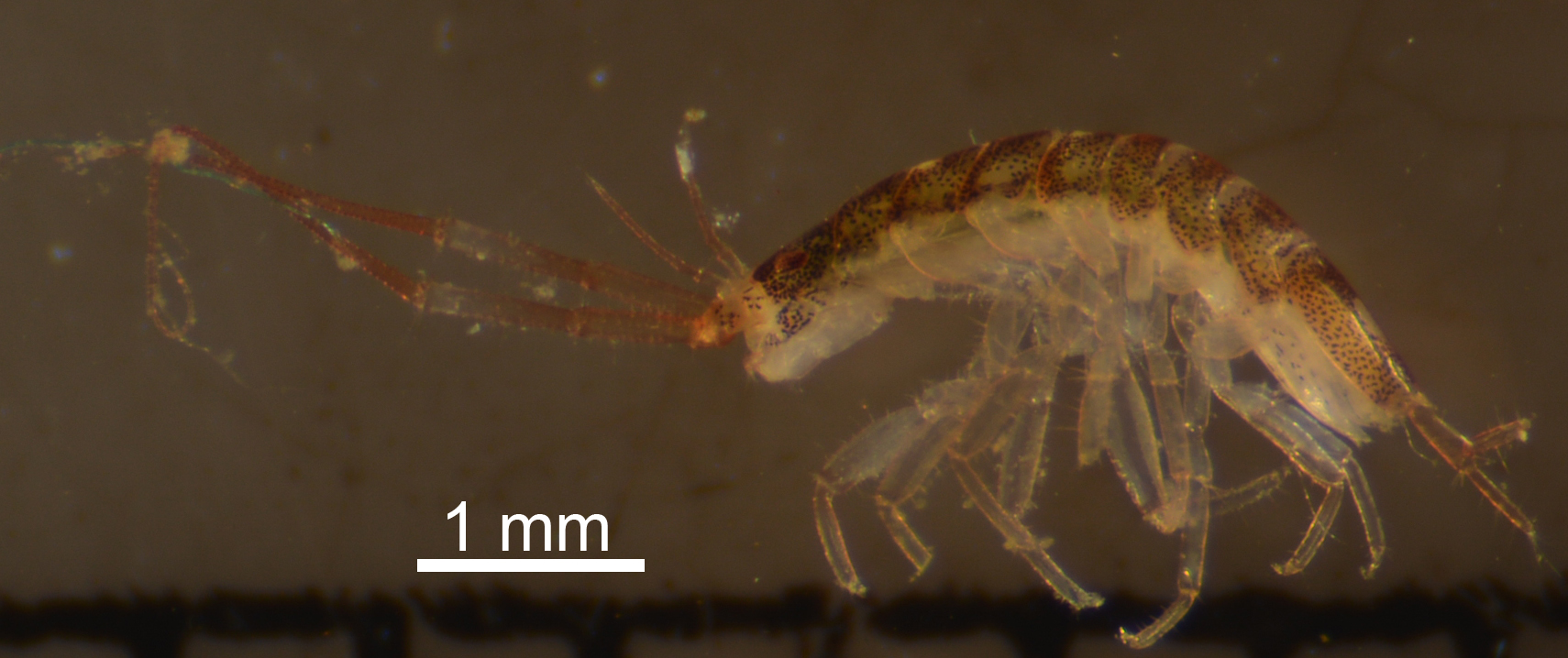An isopod specimen was obtained in the intertidal zone of Oshoro Bay, Hokkaido, Japan, about 43°20′N, 140°85′E, on 19 May 2014 by Motoko Kobayashi, photographed and fixed in 99% EtOH by Takumi Onishi; the specimen was tentatively identified by Hiroshi Kajihara as Ianiropsis longiantennata by a reference to Nunomura (1995). Total DNA was extracted from the posterior half of the body using the silica method (Boom et al. 1990) with some modifications. Extracted DNA was dissolved in 30 µl of deionized water and has been preserved at –20°C. Remaining morphological voucher specimen has been deposited at the Hokkaido University Museum under the catalogue number ICHU2120064 (contact: Dr. Hiroshi Kajihara, kazi@mail.sci.hokudai.ac.jp).
PCR amplification of the mitochondrial cytochrome c oxidase subunit I gene (COI) using LCO1490 (5′-GGTCAACAAATCATAAAGATATTGG-3′) and HCO2198 (5′-TAAACTTCAGGGTGACCAAAAAATCA-3′) (Folmer et al. 1994) was unsuccessful. We then used 16S ar-L (5′-CGCCTGTTTATCAAAAACAT-3′) and br-H (5′-CCGGTCTGAACTCAGATCACGT-3′) (Palumbi et al. 1991) for the 16S rRNA gene. PCR products were visualized by electrophoresis in 1% agarose gel. A hot start PCR was performed by a thermal cycler, 2070 Thermal Cycler (Applied Biosystems), in a 20-µl reaction volume containing 1 µl of template total DNA (approximately 10–100 ng) and 19 µl of premix made with 632-µl deionized water, 80-µl Ex Taq Buffer (TaKara Bio), 64-µl dNTP (each 25 mM), 8-µl each primer (each 10 µM), and 0.1-µl TaKara Ex Taq (5 U/µl,TaKara Bio). Thermal cycling condition comprised an initial denaturation at 95°C for 30 sec; 30 cycles of denaturation at 95°C for 30 sec, annealing at 45°C for 30 sec, and elongation at 72°C for 45°C and a final elongation at 72°C for 7 min.
The PCR product was purified with the silica method (Boom et al. 1990). Both strands were sequenced with a BigDye® Terminator v3.1 Cycle Sequencing Kit (Applied Biosystems) following the manufacturer's protocol, using the same primer set as the initial PCR amplification. Sequencing was performed with ABI Prism 3730 DNA Analyzer (Applied Biosystems). Chromatogram and sequence data were operated with MEGA v5 software (Tamura et al. 2011).
Results
Phylum Arthropoda
Subphylum Crustacea
Class Malacostraca
Order Isopoda
Suborder Asellota
Family Janiridae Sars, 1897
Genus Ianiropsis Sars, 1897
Cf. Ianiropsis longiantennata Thelemann, 1910
[Japanese name: umi-mizumushi]
(Figs 1, 2)
Janiropsis [sic] longiantennata: Nunomura (1995), p. 214, pl. 81-11.
A total of 454 bp of the mitochondrion-encoded 16S rRNA gene sequence was determined from Ianiropsis longiantenntata (see Appendix). A nucleotide BLAST search (Altschul et al. 1997) at the NCBI website (https://blast.ncbi.nlm.nih.gov/) showed that our sequence was most similar to AF260858 (90% similarity; E value = 3e–160; 98% in query coverage), a 16S rRNA gene partial sequence of an isopod identified as Ianiropsis epilittoralis Menzies, 1952 collected in California, USA (Wetzer 2001). There was no 16S sequence of I. longiantennata deposited in GenBank as of writing. Ianiropsis longiantennata was described by Thielemann (1910) based on material (two specimens, male and female) collected by Franz Doflein in 1904, probably waters around the Misaki Marine Biological Station, although Thilemann (1910: 70) stated "Eine nähere Angabe der Lokalität fehlt" (a more detailed information about the locality was lost [HK's translation]).

Fig. 1. ICHU2120064, lateral view, tentatively identified as Ianiropsis lonogiantennata from Oshoro Bay, Hokkaido, northern Japan.

Fig. 2. Cf. Ianiropsis lonogiantennata (ICHU2120064), dorsal view.
References
Altschul, S. F., Madden, T. L., Schäffer, A. A., Zhang, J., Zhang, Z., Miller, W., and Lipman, D. J. 1997. Gapped BLAST and PSI-BLAST: a new generation of protein database search programs. Nucleic Acids Research 25: 3389–3402.
Boom, R., Sol, C. J. A., Salimans, M. M. M., Jansen, C. L., Wertheim-van Dillen, P. M. E., and van der Noordaa, J. 1990. Rapid and simple method for purification of nucleic acids. Journal of Clinical Microbiology 28: 495–503.
Folmer, O., Black, M., Hoeh, W., Lutz, R. and Vrijenhoek, R. 1994. DNA primers for amplification of mitochondrial cytochrome c oxidase subunit I from diverse metazoan invertebrates. Molecular Marine Biology and Biotechnology 3: 294–299.
Nunomura, N. 1995. Isopoda. Pp. 205–233. In: Nishimura, S. (Ed.) Guide to Seashore Animals of Japan, with Color Pictures and Keys, Vol. II. Hoikusha, Osaka.
Palumbi, S., Martin, A., Romano, S., McMillan, W. O., Stice, L., Grabowski, G. 1991. The Simple Fools Guide to PCR, Ver. 2. Department of Zoology and Kewalo Marine Laboratory, University of Hawaii, Honolulu, 45 pp.
Tamura, K., Peterson, D., Peterson, N., Stecher, G., Nei, M., and Kumar, S. 2011. MEGA5: molecullar evolutionary genetics analysis using maximum likelihood, evolutionary distance, and maximum parsimony methods. Molecular Biology and Evolution 28: 2731–2739.
Thielemann, M. 1910. Beiträge zur Naturgeschichte Ostasiens. Herausgegeben von Dr. F. Doflein. Beiträge zur Kenntnis der Isopodenfauna Ostasiens. Abhandlungen der mathematisch-physikalischen Classe der Königlich Bayerischen Akademie der Wissenschaft Suppl. 2: 1–109, pls 1–2.
Wetzer, R. 2001. Hierarchical analysis of mtDNA variation and the use of mtDNA for isopod (Crustacea: Peracarida: Isopoda) systematics. Contributions to Zoology 70: 23–39.
Appendix16S rDNA sequence from ICHU2120064 identidied as Ianiropsis littoralis(Thielemann, 1910)
CTTGTCAGGTGGTAGCCTCTGCTCAATGAATTAAATAGCCGCAGTATCTTGACTGTGCTAAGGTAGCATAGTAGTTAGTTTATTAATAGTAAACTTGAATGAAAGAGCTGACAACTTCTCACAGTACTGGCTTAAAGATGTGAAATTATAATACTAGTAAAAATACTAGTTTCCCCAATTAGACGACAAGACCCTGTGAAGCTTTACTTTGTTCCATTATTCAGGATACTACCTAAAGTTGAGCTGGGGCGGCACCTAAGTTAAACCTTAGTAAATACAACCTTCGGGAGTCTAAAGACCTTCAAAATAAATAAAACAAGCTACTCCAGGGATAACAGCACAATTCTTCTATAGAGCCCTTATCGACAGAAGAGAGTTGTGACCTCGATGTTGAATTGAGCTGGCTCAGGAGGGCGAGTCCCTTCTAAGAGTAAGTCTGTTCGACTTTTAATAG